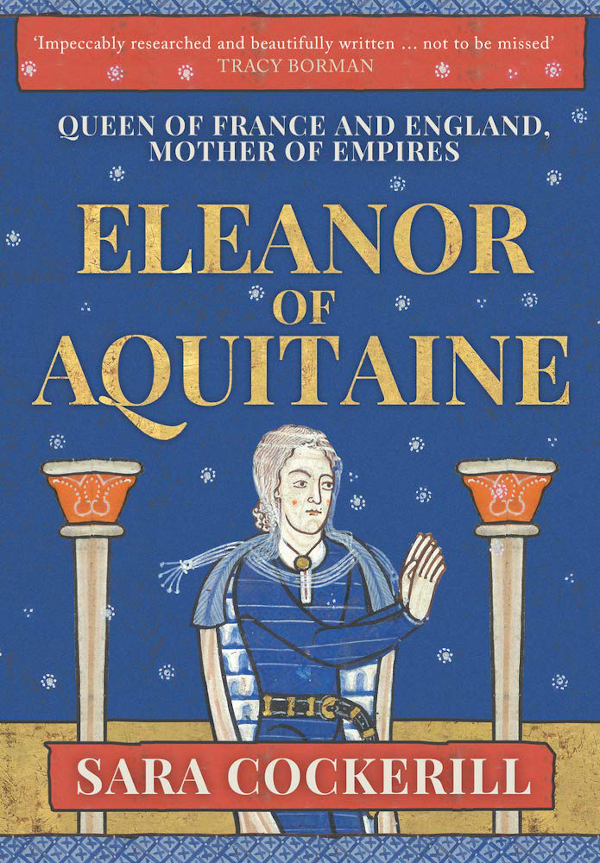
“Writing about Eleanor of Aquitaine has been a very different experience to writing about Eleanor of Castile. With the latter, my almost universal experience was that people had no idea at all who she was. Indeed, if they claimed they had any idea, they were probably confusing her with Eleanor of Aquitaine. With the senior Eleanor, however, the experience has been in this respect wildly different – nearly everyone has some idea of who Eleanor of Aquitaine was.”
Sara Cockerill “Eleanor of Aquitaine”
I have always been fascinated by Eleanor of Aquitaine, but, unlike a dedicated legion of Eleanor enthusiasts, I couldn’t claim to know much about her. In the few times I have seen Eleanor depicted in fiction she seems a distant, matriarchal authority figure. While I knew rudimentary facts about Eleanor’s life, I did not know much about her historiography, and her historiography overshadows her life. Sara Cockerill’s latest biography reveals the mythological aspects of Eleanor’s story, some of which can only be be described as shocking; tales so superstitious, salacious and sleazy that scholars refer to the period many were written in as the time of the ‘Black Legend’. Sara joins us today to discuss her latest book, Eleanor of Aquitaine: Queen of France and England, Mother of Empires and the creation of Eleanor’s mythology.
O.H.: Sara, you wrote that you had read and enjoyed just about every biography of Eleanor that’s been written, before you wrote your own book. Can you tell us about the picture you had of Eleanor before you began research, and what may have changed during the course it?
S.C.: Yes, of course! The reason I picked Eleanor as the subject for my second book was not because I had an agenda – I loved the picture I had of her. That was very much a conception of her as a proto-feminist, defying the musty conventions of C12 century life and exercising unparalleled power. And the fabled beauty thing was probably in the mix too! I picked her as a subject for two reasons – I wanted to understand how she did what she did, and because I felt that existing biographies oddly enough didn’t focus enough on her, tending to get distracted into her famous husbands and sons – particularly during that 15 year period when she was imprisoned…So I started just wanting to understand the story better. What really shocked me as I researched was how much of the picture I had absorbed over the years rested on very flimsy – or no – foundations. And another thing I found very interesting was how much scholarship there was out there pointing out these things – Michael Evans even wrote a whole book about the Eleanor myths (Inventing Eleanor) – and how little traction that scholarship had gained as far as most readers were concerned.
So by the end of the writing process I still saw Eleanor as a remarkable woman, but in a different way to my first ideas and much less unique in some respects. So she emerged as far less unconventional than I had imagined, far less generally defiant. And she emerged as one of a cadre of remarkable women exercising power, not the sole unicorn. But I was awed by her physical resilience (read the chapter on the Crusade – that has always been somewhat rushed through before – and you suddenly realise what physical hardship she endured). I was disconcerted, but interested, to find her a very good daughter of the Church, and passionate about her role as a mother. I was amazed by the way she emerged from two marriages where her ability to exercise power was very limited, and fifteen years of imprisonment, to become in her later years not just powerful, but politically immensely deft. As a “woman of a certain age” myself, with many friends who are contemplating or engaging with the post children return to work I found her immensely inspiring!
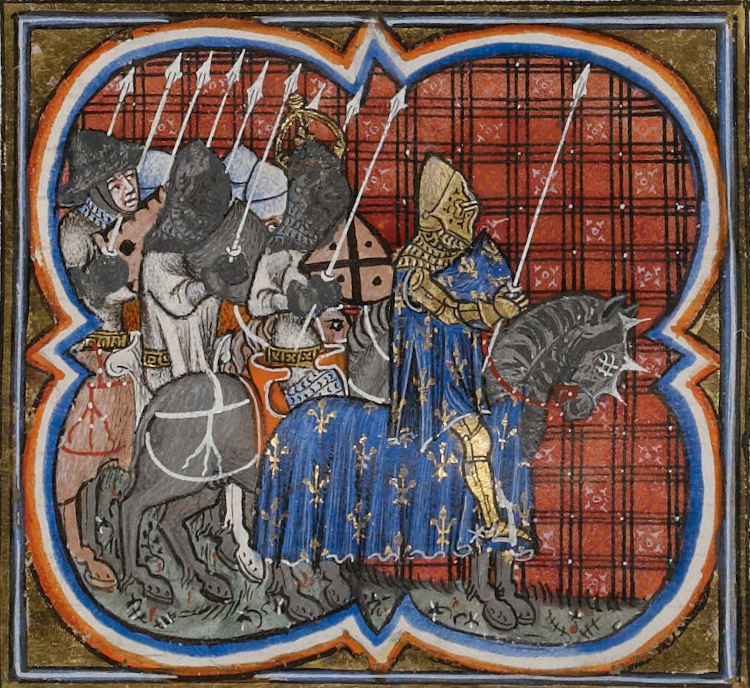
O.H.: What has struck me, particularly looking over the appendix where you list Eleanor’s witnesses, is that almost all of Eleanor’s early history was created by men. You mention that even some letters she supposedly penned were almost certainly written by Peter of Blois. How has the medieval masculine viewpoint affected the way Eleanor’s story has been written?
S.C.: It’s been very significant. The most obvious is that direct evidence on what Eleanor does is actually minuscule, because the vast majority of chroniclers were male clerics who were trained to disapprove of women, and to regard active agency by women as sinful. So they don’t mention her at all unless they can’t help it. Which means that we have quite good accounts of their abbey’s trivial fights about matters of local interest (sigh), and great tracts of Eleanor’s (far more interesting) life where so much has to be inference. One example which still leaves me with blue smoke coming out of my ears is the way that Odo of Deuil, the French chronicler of the Second Crusade, seems to have ex post facto edited Eleanor out of his chronicle on the basis that he disapproved of her, and did not want her to be remembered. There are just two reference to her in the whole book, and they appear to be oversights – when deleting passages about her he missed these.
O.H.: Eleanor divorced her first husband, then married a younger man in what broke down into a famously unhappy marriage, ending in her imprisonment. How do you think ideas about Eleanor have been influenced because of her marriages, both by medieval and her later scholars?
S.C.: Oh, her marriages have absolutely defined the terms in which she has been written about throughout. Part is inevitable – Queen of both France and England – that is such a good story, that one cannot resist it as a hook; but as soon as we say “Queen” it throws her husbands into sharp focus. Which means that at the time and for centuries after, Eleanor gets a billing by reference to her relationships with them. One of the earliest takes on her is as “the Bad Wife”, which segues nicely into seeing her as “the Bad Mother”. But even the fairly recent attempts to cast her in feminist mould buy into this marriage perspective: Amy Kelly defined Eleanor for a generation by calling her book “Eleanor of Aquitaine and the Four Kings”. To an extent that is really difficult to avoid, because so much of the history, the chronicles and the surviving correspondence relates to the actions of the kings. One ends up having to infer Eleanor’s location from the locations of her husbands’ charters, or from expenses paid in their account books to house her elsewhere. At the same time the fact of her having been a queen twice over drives a particular view of her as exceptional, as if she must be intrinsically the most outstanding woman of her generation just because of who she married. But of course in reality she married kings because she was an heiress, not because she was picked out as exceptionally talented. Yet it is practically impossible to start looking at her and her actions from a position of neutrality because of the baggage created by her marriages themselves – even before one gets to the events of those marriages!
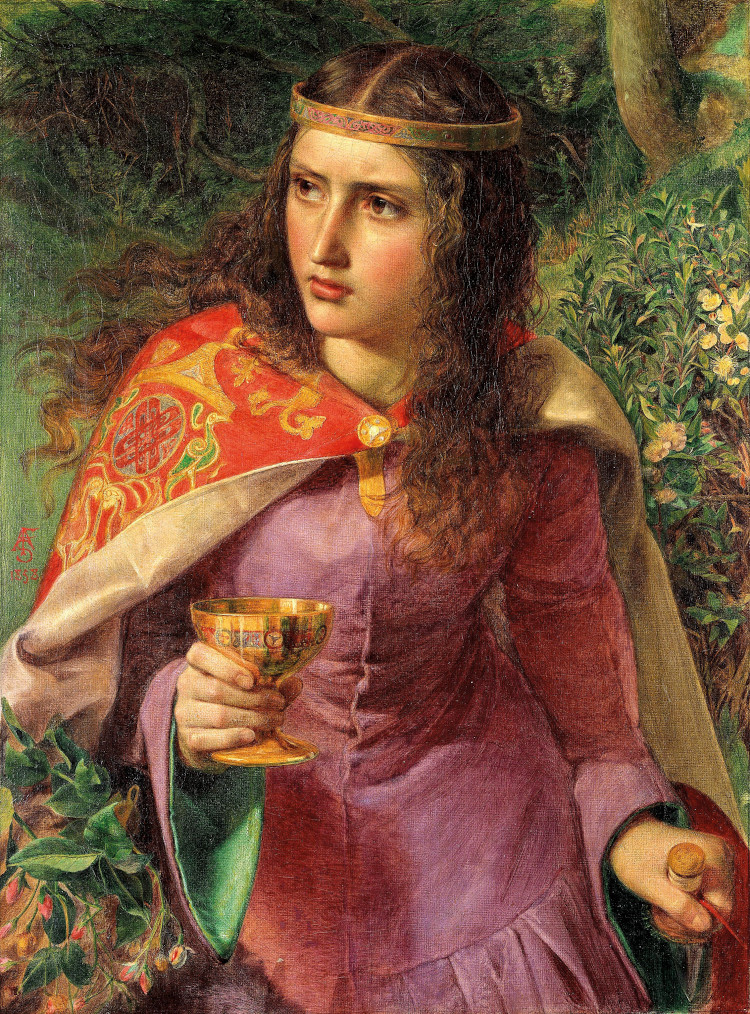
It is a story recorded in two separate Norman vernacular histories, probably of the thirteenth century – one in Cambridge and one in the Bibliotheque de l’Arsenal in Paris. The story they tell goes like this:
Now, King Louis hated his wife Eleanor, who was the heir of Aquitaine and Poitou … The king had himself separated from his wife, at Étampes. Her men of Poitou came to her there to take her away …. After she had been divorced, she surveyed her own people, she disrobed and said, ‘Gentlemen, what kind of beast am I?’ ‘By God,’ they said, ‘there is no more beautiful woman alive today.’ Cockerill ‘Eleanor of Aquitane’ p. 158
‘Then gentlemen,’ she said, ‘I am not the devil that the King of France called me just now.’
O.H.: I think we can suggest that some of the more salacious stories of the earlier centuries are based on contemporary views of women, particularly as so many of the men writing about her were churchmen. Yet some of those stories have been perpetuated for centuries. Why do you think people writing about Eleanor have so often continued to connect her with sex, with stories of incest, infidelity, seduction and flaunting her sexuality?
S.C: One reason is that the base material was left there by chroniclers writing a few years after the events – often around the time that Eleanor was imprisoned, when Henry was keen to brief against her in hopes he might manage a divorce; or at the time that Philip Augustus was strongly engaged in badmouthing the whole family. You then get a base set of chronicles which can (if you squint a bit and persuade yourself that twenty or fifty years is “near enough”) be called contemporary, which do have whiffs of all of these things about them. Sex is used because that is the perfect tool for the time to use against a woman. Infidelity, incest, even overt use of sexuality are simply signs for those reading at the time that say “Bad”, when what may really be being disapproved of is the fact of her power. And of course we can’t entirely claims to have shaken that particular mindset, even today! Think about the Howard/Heidi paradigm Sheryl Sandberg cited in “Lean In” – people look for reasons to disapprove of successful women…
O.H.: I thought that the story of Eleanor presiding over a “Court of Love” in Poitiers seemed to contradict the ‘diabolical’ view of Eleanor. Why do you think this particular story entered her mythology?
S.C.: There is no mystery about this – one can trace its advent very clearly. I’m afraid this was one of those cases of an attempt to create a feminist story for Eleanor out of the pitiful sources, meeting up with material which was not fully understood. By the late C20th we understandably have a wave of feminist historians looking for Eleanor’s narrative – and finding very little real material. Some of them find this wonderful book by Andreas Capellanus which on its face describes Eleanor as part of a Court of Love held by eminent ladies of the time to assist men in their romantic dilemmas (and to mock them a bit, too). And those writers (who shall remain nameless!) take it at face value, when a bit of further digging would have revealed that it simply can’t be true. There is no other mention of it. At the time the book was written Eleanor was imprisoned by Henry. A number of the other participants were verifiably off doing other things. There is no sign that Eleanor ever met most of them. And most of the stories, when you think about them, are actually jokes – like Eleanor ruling on whether an older honourable husband (like Louis) is to be preferred over a younger dynamic one (like Henry …).
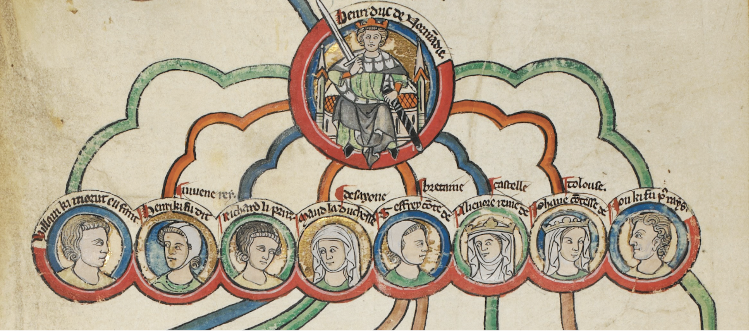
O.H.: Another archetype attributed to Eleanor is the “cold and distant mother”, yet you question this throughout your study. Can you tell us what you discovered about Eleanor as a mother?
S.C.: This was an odd one. I had no particular ideas about this – as far as I was concerned the “cold distant mother” concept was simply taking an impermissibly modern view of what was the (I thought) inevitable paradigm for a woman with her responsibilities as Queen and ruler, in an era when sub-contracting childcare was the norm for noble households. But once I became immersed in Eleanor’s life I was struck by how often she travelled with her small children – far more, for example, than Eleanor of Castile did. And when you start to piece it together, the case for Eleanor as a woman who both very much wanted children, and valued them, became a very strong one. She plainly wanted children with Louis – even seeking Bernard of Clairvaux’s help to persuade Louis to get on with his marital duties. Wherever she can be with her children, she apparently is with them. With her we have what appears to be the first surviving record for a child’s birthday party – pork and sheep being bought specifically for Young Henry’s party. And then we can see her children being fond of and influenced by her. Each of her sons, despite separation from her household at an early age, sticks his neck out for Eleanor. Young Henry intercedes for her on his deathbed, Richard is famously devoted to her and leaves her in charge, Geoffrey calls a daughter after her, John rushes to rescue her. And the daughters show at least equal signs of fondness – Matilda comes to bear her last child with Eleanor while Eleanor is in captivity, and leaves two of her children with her mother; Joanna runs to her side in time of crisis. And even successful, independent Queen Leonor of Castile corresponds with her, and takes her advice on which daughter to send into an important marriage alliance. Then on top of these there are constant glimpses of children in crisis for whom Eleanor cared, on occasion by fostering them herself. No two ways about it, motherhood was a big part of her identity – far far more than I had thought!
O.H.: Many of the men in Eleanor’s family are notorious historical figures; her husband Henry II, her sons Henry the Young King, Richard I and John I, all of them connected to notorious incidents in history. How do you think these men inform views on Eleanor?
S.C.: In some ways, as I say, their exceptional profile has created an expectation of Eleanor as exceptional. In some ways they have dictated the development of the Black Legend. Their enemies have been Eleanor’s enemies too – defaming her defames them. That is very apparent in Philip Augustus’s propaganda. The fights between her sons and Henry II, and between themselves, have also tended to feed into perceptions of her as a bad mother on an “I blame the parents” approach. So their darkness leeches into her portrayal. But they also stand in her light. Because there is so much written about them, and their male forms of agency, there has been less room for Eleanor. That she has hung on in there as a famous figure, who in fact tends to beat all of them in polls of “favourite historical figures” is a delicious irony, which I suspect none of those egocentric gentlemen would have appreciated!
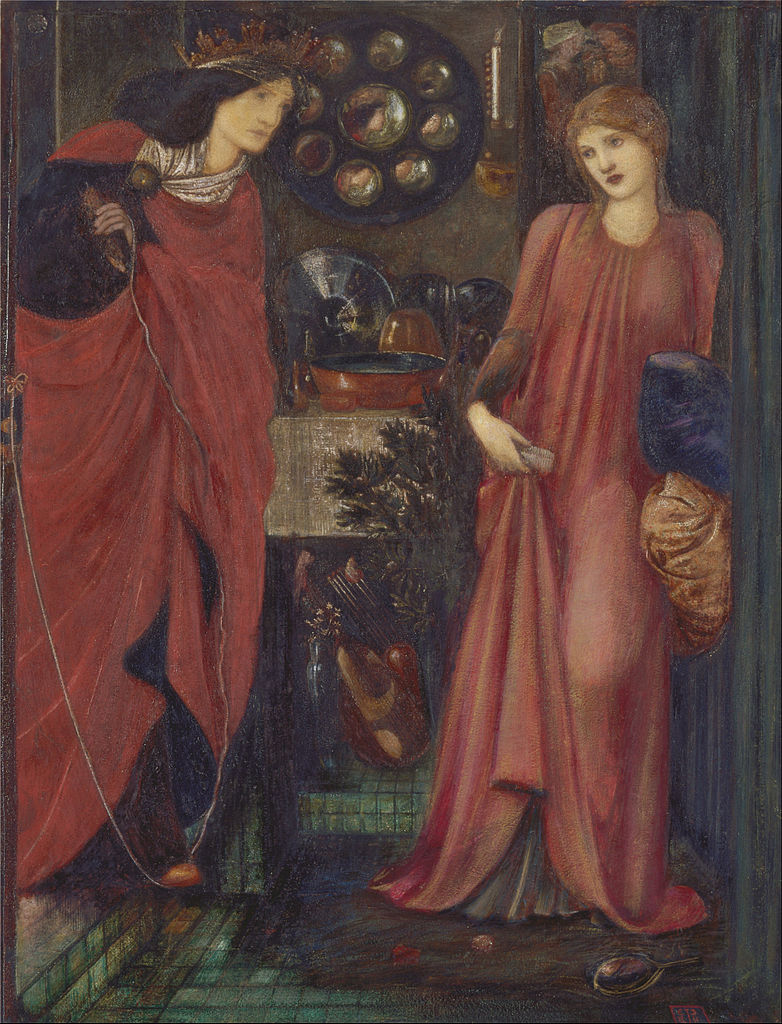
O.H.: Do you think that some aspects of Eleanor’s life have been neglected in the pursuit of maintaining the mythology of “Eleanor”?
S.C.: Oh, definitely. What annoyed me most was why, when there is such a good story – and even a reasonable amount of neglected material about her – it has been necessary to make up so many stories. Why not just stick with the truth? One aspect is the story of her as a mother. Another is her engagement with religious affairs. Because we are such a secular society this seems to have been regarded as not worth looking at – and it conflicted with the feminist “Eleanor the feminist rebel” narrative. But the material is there demonstrating that Eleanor was closely engaged with the Church throughout her life, and was personally close to and reliant on a succession of some of the most remarkable churchmen of her age: Geoffrey de Loroux (aka the proto-theologian Geoffrey Babion), Bernard of Clairvaux (who actually wrote to her in very friendly terms), Gilbert of Poitiers, John of Salisbury, Jordan Fantosme, Abbot Luke of Turpenay and of course Pope Celestine III himself. One of the ironies which has confronted me is that if Eleanor had not been so close to the church, Henry II would probably have got his divorce, and Eleanor’s narrative would have been very different. Another related aspect which came into view was that there seems to be a good basis for saying that Eleanor was a fan of, and promoted the veneration of, St Radegonde – another heiress with what might well be termed “family troubles”.
O.H.: I have really been enjoying Eleanor of Aquitaine’s Life Lessons for Lockdown over on your Facebook page, can you tell our readers about the inspiration for this?
S.C.: It was really as simple as being rather sad and low in the early days of lockdown, and thinking to myself “Come on now, it’s hardly 15 years imprisonment like Eleanor of Aquitaine had to endure”. And because I tend to think of her and Eleanor of Castile as my “life coaches”, I wondered what lessons Eleanor would have for me from her experience. I found the thoughts very helpful, and it occurred to me that other Eleanor fans probably would too!
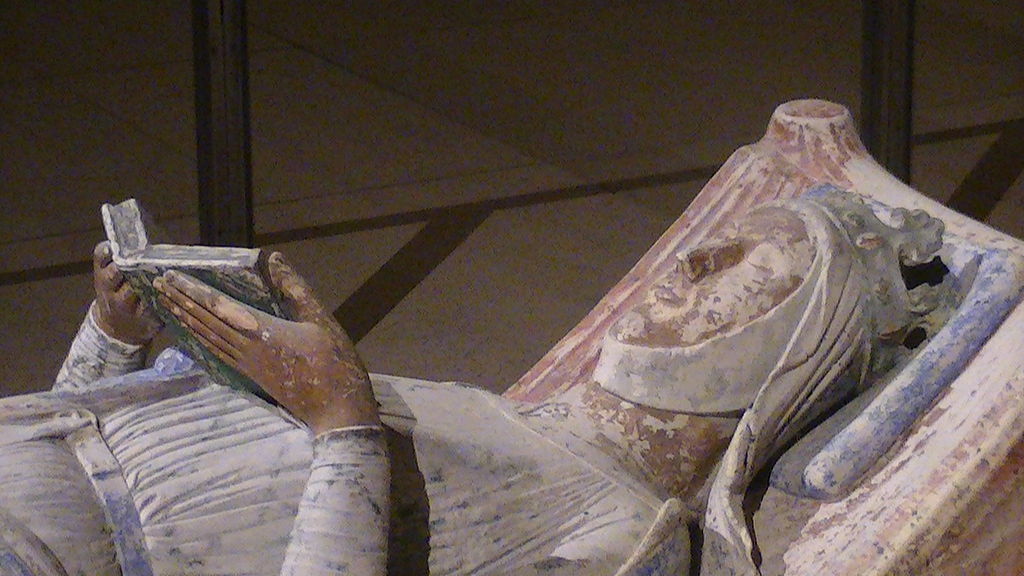
Eleanor of Aquitaine: Queen of France and England, Mother of Empires
 Eleanor of Aquitaine’s story sometimes seems so extreme it ought to be made up. The headlines: orphaned as a child, Duchess in her own right, Queen of France, crusader, survivor of a terrible battle, kidnapped by her own husband, kidnapped by pirates, divorced for barrenness, Countess of Anjou, Queen of England, mother of at least five sons and five daughters, rebel against her own husband, prisoner for 15 years, ruler of England in her own right, traveler across the Pyrenees and Alps in winter in her seventies, and mentor to the most remarkable Queen medieval France was to know (her own granddaughter, obviously). Eleanor of Aquitaine’s life has also been subjected to successive reinventions over the years, with the facts often losing the battle with speculation and wishful thinking. In this biography Sara Cockerill has gone back to the primary sources, and the wealth of recent first rate scholarship, and assessed which of the claims about Eleanor can be sustained on the evidence. The result is a complete re-evaluation of this remarkable woman’s even more remarkable life. A number of often repeated myths are debunked and a fresh version of Eleanor emerges. In addition Sara Cockerill has added her own research, breaking new ground on Eleanor’s relationship with the Church, her supposed antipathy to Thomas Becket and her relationships with all of her children, including her family by her first marriage.
Eleanor of Aquitaine’s story sometimes seems so extreme it ought to be made up. The headlines: orphaned as a child, Duchess in her own right, Queen of France, crusader, survivor of a terrible battle, kidnapped by her own husband, kidnapped by pirates, divorced for barrenness, Countess of Anjou, Queen of England, mother of at least five sons and five daughters, rebel against her own husband, prisoner for 15 years, ruler of England in her own right, traveler across the Pyrenees and Alps in winter in her seventies, and mentor to the most remarkable Queen medieval France was to know (her own granddaughter, obviously). Eleanor of Aquitaine’s life has also been subjected to successive reinventions over the years, with the facts often losing the battle with speculation and wishful thinking. In this biography Sara Cockerill has gone back to the primary sources, and the wealth of recent first rate scholarship, and assessed which of the claims about Eleanor can be sustained on the evidence. The result is a complete re-evaluation of this remarkable woman’s even more remarkable life. A number of often repeated myths are debunked and a fresh version of Eleanor emerges. In addition Sara Cockerill has added her own research, breaking new ground on Eleanor’s relationship with the Church, her supposed antipathy to Thomas Becket and her relationships with all of her children, including her family by her first marriage.
Available now at Amazon and Book Depository.
 Sara Cockerill studied law at the University of Oxford. She is a practising QC specialising in commercial law, and the author of a leading specialist legal text. She has had a lifelong interest in English history and has devoted her spare time over the past ten years to researching the life of Eleanor of Castile. She is married with one cat, and divides her time between London and the seaside. Eleanor of Castile: The Shadow Queen is her first published work of history.
Sara Cockerill studied law at the University of Oxford. She is a practising QC specialising in commercial law, and the author of a leading specialist legal text. She has had a lifelong interest in English history and has devoted her spare time over the past ten years to researching the life of Eleanor of Castile. She is married with one cat, and divides her time between London and the seaside. Eleanor of Castile: The Shadow Queen is her first published work of history.
Visit Sara at saracockerill.com
Eleanor of Aquitaine, Queen of France and England Facebook page

